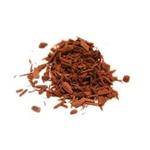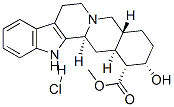Yohimbine Hydrochloride: From Probing CYP2D6 Activity to Its Diverse Therapeutic Potential and Risks
Yohimbine hydrochloride increases the amount of blood that is allowed to flow into the penis and prevents blood from flowing out of the penis. It can cause an erection. Yohimbine is used to treat and diagnose some types of impotence. Yohimbine hydrochloride may also be used for purposes other than those listed in this product guide.

Oral Yohimbine hydrochloride as a New Probe Drug to Predict CYP2D6 Activity
Major variability in drug exposure results from large differences in drug-metabolising enzyme activities. Currently, genotyping and phenotyping tests are used to assess cytochrome P450 (CYP) activity. Although genotyping is a tempting approach propagated widely to define variability, the influence of environmental factors on CYP450 activity is not captured by genotyping. Yohimbine hydrochloride is an α2-receptor antagonist licensed in Germany (since 1978) as well as Canada (since 1951) for erectile dysfunction but pharmacodynamic effects are not fully understood. In vitro data indicate that CYP2D6 seems likely to catalyse the specific transformation of yohimbine into 11-OH-yohimbine. We therefore evaluated in a clinical study the potential of yohimbine as a phenotyping probe drug using a therapeutic dose as well as a microdose of yohimbine in a CYP2D6 panel study. Moreover, a further objective was to investigate the effect of CYP2D6 inhibition by paroxetine on Yohimbine hydrochloride pharmacokinetics after a therapeutic dose and microdose. The combination of microdosed yohimbine with the established microdosed CYP3A probe drug midazolam was also studied.[1]
After administration of an oral therapeutic dose of yohimbine (5 mg) as well as a microdose (50 µg), highly variable pharmacokinetics of yohimbine and its main metabolite in plasma 11-OH-yohimbine were observed. The apparent oral clearance of Yohimbine hydrochloride in this healthy volunteer population varied more than 600-fold from 25.3 to 15,864 mL/min after the single oral 5-mg dose and even more than 900-fold from 39.6 to 38,822 mL/min after the single oral 50-µg dose. This variability is clearly associated with the polymorphic CYP2D6 enzyme because yohimbine clearance was highest in CYP2D6 EMs and lowest in PMs. Calculating the fractional clearance of yohimbine via CYP2D6 by 1-(AUCEM/AUCPM) using the mean values of both genotype groups after the 50-µg administration results in 0.995, which demonstrates the almost exclusive and complete elimination of Yohimbine hydrochloride via the CYP2D6-mediated 11-hydroxylation. In a pharmacokinetic study using oral and intravenous yohimbine, 1 out of 12 healthy study participants showed a 15-fold reduced yohimbine clearance. This slow metaboliser was said to co-segregate with the CYP2D6 polymorphism. A larger study involving 172 volunteers to investigate the α2-adrenegic blockade demonstrated that after a 15-min Yohimbine hydrochloride infusion no concentration of the metabolite 11-OH-yohimbine was measurable at this time point in 17 volunteers.
Certainly, the small number of participants in the PM and IM groups is a limitation of this investigation. However, because results of the genotype groups for Yohimbine hydrochloride exposure, clearance and half-life were large and clearly separated, the conclusions of this trial are justified. Indeed, the main interest was the ability to determine the activity of CYP2D6, which was achieved. In addition, CYP2D6 inhibition resulted in the expected decrease of Yohimbine hydrochloride clearance in EM and IM participants whereas insignificant changes in PMs were expected because of a lack of functional enzymes and/or alternative pathways. Unfortunately, no ultra-rapid metaboliser could be identified during the genotype screening. The highest observed clearance of yohimbine 50 µg was 38.8 L/min, which might even be much higher in ultra-rapid metabolisers, which would then result in a more than 1000-fold difference in yohimbine clearance in the population. A therapeutic dose (5 mg) and microdose (50 µg) of yohimbine were successfully applied to evaluate the CYP2D6 activity in CYP2D6 genotyped healthy persons. CYP2D6 inhibition significantly decreased yohimbine clearance. Microdosed Yohimbine hydrochloride can also be combined with microdosed midazolam to simultaneously determine CYP2D6 and CYP3A activity. Microdosed Yohimbine hydrochloride seems to be exclusively eliminated by CYP2D6 and is therefore an excellent candidate to become a reference probe drug for CYP2D6 activity assessment.
Multifaced Nature of Yohimbine hydrochloride
Later on Yohimbine hydrochloride, Munster et al. studied whether yohimbine acts as an acute pharmacological stressor influencing decision-making in male rats. By blocking receptors that typically inhibit norepinephrine release, yohimbine increases arousal and stress responses. Systemic administration of yohimbine significantly increased preference for a risky/large reward lever over a certain/small reward, suggesting that it enhances risk-taking in reward-based decisions. Interestingly, corticosterone, another stress-related hormone, did not produce a similar effect, indicating that Yohimbine hydrochloride possesses unique properties that specifically promote risky choices. Further investigation revealed that blocking dopamine D1 receptors in the dorsal prelimbic cortex reduced the yohimbine-induced preference for the risky option, suggesting that activating these receptors is crucial for yohimbine’s influence on risk-taking. These findings provide causal evidence that stimulating PL D1 receptors may be a neurochemical mechanism by which yohimbine, and potentially other stressors, affect decision-making processes related to risk. Furthermore, Yohimbine hydrochloride has been investigated for its potential effects on impulsivity and other aspects of behavioral control. Studies by Herman et al. have explored its role in conditions like ADHD and PTSD, where impulsivity is a prominent feature.[2]
Yohimbine hydrochloride presents a complex interplay of beneficial and detrimental effects, highly contingent upon its concentration—at lower doses demonstrating promising therapeutic potential. For instance, a 5 mg/kg/day dose significantly reduced hepatic sulfate levels to control values and induced rhodanese expression, an enzyme crucial for sulfur metabolism. This higher dose also demonstrated a reduction in lipid peroxidation, indicating a protective effect against oxidative stress. A lower dose of 2 mg/kg/day also showed a trend towards decreased sulfate levels, although this effect was not statistically significant. Interestingly, the 2 mg/kg/day dose restored cystathionine γ-lyase activity to control levels, an effect not observed with the higher dose. These findings suggest that Yohimbine hydrochloride’s effects on sulfur metabolism and oxidative stress are dose-dependent, with different mechanisms potentially activated at varying concentrations. Yohimbine hydrochloride demonstrates therapeutic potential in various conditions like erectile dysfunction, weight loss, metabolic disorders, myocardial dysfunction, depression, inflammatory disorders and cancer due to its interaction with multiple monoaminergic receptors and its stimulant properties from blocking α2-adrenergic receptors.
Effect of yohimbine hydrochloride hydrochloride on erectile impotence: a double-blind study
A double-blind, partial crossover study on the therapeutic effect of Yohimbine hydrochloride hydrochloride on erectile dysfunction was done in 82 sexually impotent patients. All patients underwent a multifactorial evaluation, including determination of penile brachial blood pressure index, cavernosography, sacral evoked response, testosterone and prolactin determination, Derogatis sexual dysfunction inventory and daytime arousal test. After 1 month of treatment with a maximum of 42.0 mg. oral yohimbine hydrochloride daily 14 per cent of the patients experienced restoration of full and sustained erections, 20 per cent reported a partial response to the therapy and 65 per cent reported no improvement. Three patients reported a positive placebo effect. Maximum effect takes 2 to 3 weeks to manifest itself. Yohimbine hydrochloride was active in some patients with arterial insufficiency and a unilateral sacral reflex arc lesion, and in 1 with low serum testosterone levels. The 34 per cent response is encouraging, particularly in a Veterans Administration population presenting with a high incidence of diabetes and vascular pathological conditions not found in regular office patients. Only few and benign side effects were recorded, which makes this medication worth an attempt, often as a first line of treatment even at a dose of 8 tablets.[3]
References
[1]Vay M, Meyer MJ, Blank A, Skopp G, Rose P, Tzvetkov MV, Mikus G. Oral Yohimbine as a New Probe Drug to Predict CYP2D6 Activity: Results of a Fixed-Sequence Phase I Trial. Clin Pharmacokinet. 2020 Jul;59(7):927-939.
[2]Nowacka A, Śniegocka M, Śniegocki M, Ziółkowska E, Bożiłow D, Smuczyński W. Multifaced Nature of Yohimbine-A Promising Therapeutic Potential or a Risk? Int J Mol Sci. 2024 Nov 29;25(23):12856.
[3]Susset JG, Tessier CD, Wincze J, Bansal S, Malhotra C, Schwacha MG. Effect of yohimbine hydrochloride on erectile impotence: a double-blind study. J Urol. 1989 Jun;141(6):1360-3.
Lastest Price from Yohimbine hydrochloride manufacturers

US $1200.00-1100.00/ton2025-10-24
- CAS:
- 65-19-0
- Min. Order:
- 1ton
- Purity:
- 99%
- Supply Ability:
- 1000T/M

US $0.00/G2025-07-25
- CAS:
- 65-19-0
- Min. Order:
- 50G
- Purity:
- 98%min
- Supply Ability:
- 30KG/month


